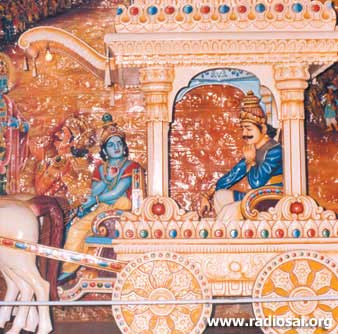 |
 |
 |
Volume
5 - Issue 05
MAY 2007 |
GITA FOR CHILDREN To download the audio of the current issue, Please click here. [6.5 MB] CHAPTER 14
6. At the purely bodily level, when a person is sleeping, he is under the spell of Tamo Guna. When he is vigourous and active, for example while playing, he is responding to Rajo Guna. And while praying or doing service, he is exhibiting Sattva Guna.’ 7. ‘All this is a broad-brush description, and I must now supplement this with some details. Firstly, you must understand that not only every human being but in fact every being is a composite of the three fundamental Gunas in some proportion or the other, with one particular Guna dominating over the others.’ 9. ‘Later, after the war is over, try out an experiment in mixing colours. Start 10. Arjuna asks, ‘Krishna, you say each person corresponds to one particular mix of the basic three Gunas. Agreed. Does this composition remain unchanged throughout the life of that person or there can be changes and fluctuations?’ 11. Krishna replies, ‘Good question! The average value, if I might say so, generally does not change, unless there is a compelling force exerted either from outside or from inside. However, daily fluctuations there could be and indeed do occur. Thus, a person may be generally Sattvic. That means he would generally be calm. However, once in a while he could get angry too. And anger rises from Rajas. Thus you have here an example of the deviation from the norm.’
15. ‘The Tamasic person is at the bottom, being a personification of dullness, sloth, inertia, laziness, and what have you. He is totally devoid of initiative, and a confirmed work-shirker! Well, that gives in a nutshell, what the three basic types of people are.’ 16. Arjuna asks, ‘Krishna, a person is Tamasic, knows that he is so and wants to change. What is he to do?’ 17. Krishna replies, ‘On account of his very nature, it is doubtful if a Tamasic person, would, of his own accord, want to change. Yet he may feel the urge, on advice from a noble soul. In such an event, laziness must be eliminated with activity; in other words, Tamas must be conquered with Rajas.’ 18. Continuing, Krishna adds, ‘While Rajas is certainly preferable to Tamas, one must not forget its undesirable aspects. In fact, Rajas has a strong tendency to get amplified. Hence, before much damage is done, Rajas itself must be vanquished with Sattva. So Tamas first with Rajas and Rajas then with Sattva.’ 19. ‘I have told you how Rajas is to be used for overcoming Tamas. Likewise, Sattva is invoked by avoiding bad company and seeking nly good company. By the way, don’t imagine that good company means only good people; a good book also can be a good companion. In this context, the scriptures must be given priority number one.’ (To be continued...) To access all the previous issues of this serial please type "Serial Gita For Children" in the search box provided above the article. – Heart2Heart Team |
| You can write to us at : h2h@radiosai.org |
Vol 5 Issue 05 - MAY 2007
|
Best viewed in Internet Explorer - 1024 x 768 resolution. |


